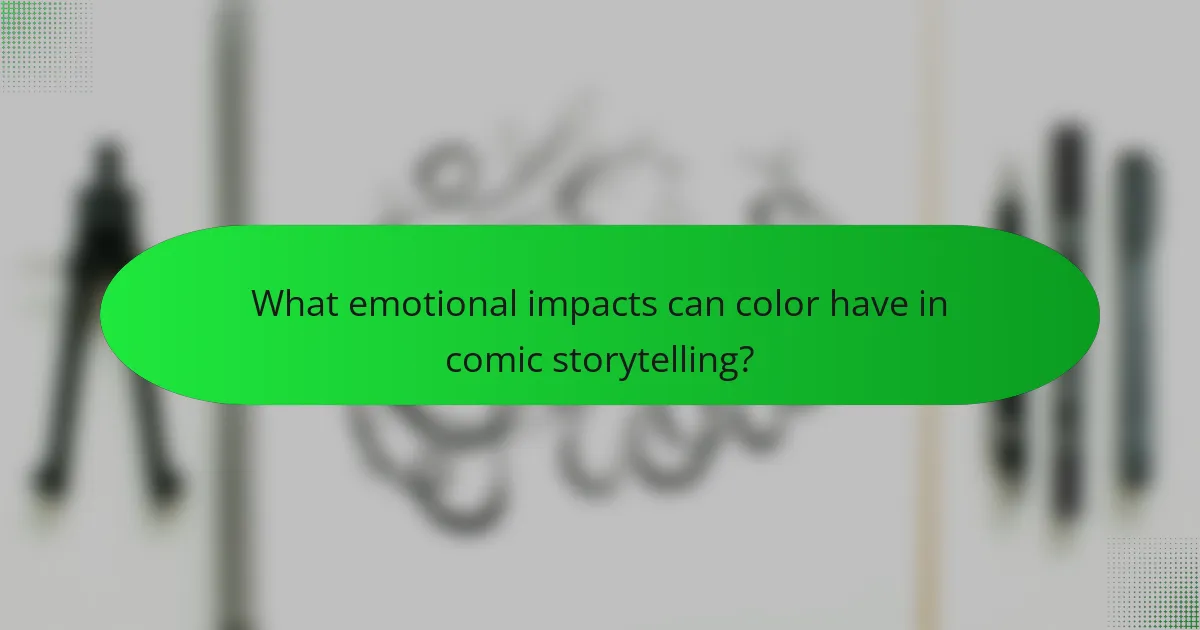Color in comic book production is a critical element that enhances storytelling and visual appeal. It influences mood, establishes atmosphere, and guides reader emotions through the use of specific color symbolism, such as red for danger and blue for calmness. The article explores the historical evolution of color printing techniques, the emotional impact of color choices on audience engagement, and best practices for effective color use in comics. Key techniques include establishing a consistent color palette, utilizing contrast to highlight important elements, and layering colors to create depth. Overall, the role of color is essential in shaping reader experiences and enhancing narrative clarity in comic storytelling.

What is the role of color in comic book production?
Color in comic book production serves to enhance storytelling and visual appeal. It helps to convey mood, establish atmosphere, and guide reader emotions. Different colors can symbolize specific themes or character traits. For instance, red often represents danger or passion, while blue can signify calmness or sadness. Color also aids in differentiating characters and settings, making the narrative clearer. Historically, color printing has evolved from simple techniques to complex digital processes. This evolution has broadened the palette available to artists, allowing for more nuanced expressions. The use of color can significantly impact a comic’s reception and reader engagement, as studies show that vibrant colors attract more attention.
How does color theory apply to comic book art?
Color theory is essential in comic book art as it influences mood, character perception, and storytelling. Artists use color to evoke emotions and highlight key elements. For instance, warm colors like red can create tension, while cool colors like blue can convey calmness. The color wheel helps artists choose complementary colors for visual harmony. This technique enhances the overall aesthetic and guides readers’ emotional responses. Studies show that color choices significantly affect viewer engagement and interpretation. Effective use of color can lead to a more impactful narrative. Thus, color theory directly shapes the visual and emotional experience in comic book art.
What are the primary color models used in comic book production?
The primary color models used in comic book production are CMYK and RGB. CMYK stands for Cyan, Magenta, Yellow, and Key (Black). This model is primarily used for print production. RGB stands for Red, Green, and Blue. This model is mainly used for digital displays. CMYK is preferred for its ability to produce a wide range of colors in printed materials. RGB is favored for its vibrant colors on screens. Both models are essential for different stages of comic book production. The choice between them depends on the final medium of the comic.
How do complementary colors enhance visual storytelling?
Complementary colors enhance visual storytelling by creating contrast and drawing attention. This contrast helps to emphasize key elements within a narrative. For example, using complementary colors can highlight a character’s emotions or actions. The visual impact of these colors can evoke specific feelings in the audience. Studies show that color contrast influences viewer perception and engagement. In comic books, this technique can guide the reader’s eye through the panels. It supports the narrative flow and enhances the overall aesthetic experience. Artists often utilize complementary color schemes to convey mood and tone effectively.
Why is color selection crucial for character development?
Color selection is crucial for character development because it visually communicates personality traits and emotions. Colors can evoke specific feelings in the audience. For instance, red often signifies passion or aggression. Blue may suggest calmness or sadness. The choice of color can influence how readers perceive a character’s motivations. Research shows that color psychology plays a significant role in storytelling. According to a study by Eisner (2008), effective color use enhances narrative depth. Therefore, thoughtful color choices are essential in shaping character identity and engagement.
How do colors reflect a character’s personality and traits?
Colors reflect a character’s personality and traits by conveying emotions and symbolism. Each color is associated with specific meanings. For instance, red often symbolizes passion or aggression. Blue can represent calmness or sadness. Yellow is frequently linked to happiness and optimism. Green may signify growth or jealousy.
In comic books, color choices enhance storytelling. They help readers quickly grasp a character’s emotional state. Research shows that colors can influence perception and mood. A study by Elliot and Maier (2014) found that color affects cognitive processing. This reinforces how colors shape character traits in visual narratives.
Additionally, characters in comics often wear colors that align with their personalities. A villain might wear dark colors to evoke fear. A hero may don bright colors to inspire hope. This visual language aids in character development and audience connection.
What are the psychological effects of different colors on readers?
Different colors have distinct psychological effects on readers. For instance, red often evokes feelings of excitement or urgency. Blue can induce calmness and trust. Yellow typically represents happiness and energy. Green is associated with nature and tranquility. Each color can influence mood and perception. Research shows that color can affect cognitive performance and emotional responses. A study by Andrew Elliot and Markus Maier indicates that red enhances attention to detail. Conversely, blue can promote creativity and open-mindedness. These effects demonstrate the importance of color choices in comic book production.
What techniques are used for color application in comics?
Color application in comics utilizes various techniques. These techniques include flat coloring, gradient fills, and digital painting. Flat coloring involves using solid colors without shading. This method provides a clean and straightforward visual style. Gradient fills create a transition between colors. This technique adds depth and dimension to characters and backgrounds. Digital painting allows for intricate detail and texture. Artists can blend colors seamlessly using software tools. Other techniques include halftone dots for shading and color holds for outlines. Each technique contributes to the overall aesthetic and emotional impact of the comic.
How do traditional and digital coloring techniques differ?
Traditional coloring techniques involve physical media such as watercolors, markers, and inks. These methods require tangible materials and manual application on paper. Digital coloring techniques utilize software like Adobe Photoshop or Procreate. These methods allow for layers, undo options, and a vast color palette.
Traditional techniques often result in unique textures and organic variations. Digital techniques provide precision and the ability to easily alter colors and effects. Traditional colors can be affected by paper type and environmental factors. Digital colors remain consistent across different displays and prints.
Both methods have distinct workflows and tools. Traditional artists may take longer to achieve desired effects. Digital artists can experiment rapidly with fewer material constraints. Each technique influences the final aesthetic of comic book art differently.
What tools and software are commonly used in comic coloring?
Common tools and software used in comic coloring include Adobe Photoshop, Clip Studio Paint, and Corel Painter. Adobe Photoshop is widely favored for its extensive features and versatility. Clip Studio Paint offers specialized tools for comic artists, enhancing workflow efficiency. Corel Painter is known for its realistic brush effects and texture options. Additionally, Procreate is popular among digital artists for its intuitive interface on iPads. These tools allow artists to create vibrant and detailed color palettes, contributing to the overall visual narrative of comics.

What emotional impacts can color have in comic storytelling?
Color in comic storytelling significantly influences emotions. Different colors evoke specific feelings and reactions. For instance, red often symbolizes passion or danger. Blue can convey calmness or sadness. Yellow typically represents happiness or optimism. Color choices can enhance narrative themes and character development. Research shows that color affects mood and perception. A study by K. J. M. van der Linde et al. (2019) found that color impacts emotional responses in visual media. This demonstrates the power of color in shaping audience emotions in comics.
How does color influence the mood of a comic book scene?
Color significantly influences the mood of a comic book scene. Different colors evoke distinct emotional responses. For example, red can signify passion or anger, while blue often conveys calmness or sadness. Yellow is associated with happiness and energy, whereas green may represent nature or tranquility. The choice of color can set the tone for the entire narrative. Studies indicate that color psychology plays a crucial role in visual storytelling. Artists use color palettes strategically to enhance emotional depth. The impact of color can guide reader interpretation and engagement with the story.
What examples illustrate the use of color to evoke specific emotions?
Red often evokes feelings of passion or anger. In comic books, it is used during intense action scenes. Blue typically conveys calmness or sadness. Artists use blue hues in scenes depicting loss or reflection. Yellow can represent happiness or caution. Bright yellow is often seen in cheerful character designs. Green is associated with nature or envy. It appears in scenes involving growth or jealousy. Purple often signifies mystery or luxury. Comic panels featuring enigmatic characters frequently use purple tones.
How can color gradients alter the perception of action sequences?
Color gradients can significantly alter the perception of action sequences by influencing emotional responses and visual dynamics. Gradients create depth and movement, enhancing the sense of speed or intensity. For example, a gradient transitioning from warm to cool colors can evoke urgency or tension. Research indicates that specific color combinations can affect viewer emotions, making scenes feel more dramatic or chaotic. Furthermore, gradients can guide the viewer’s eye, emphasizing key actions or characters within a sequence. This visual strategy can lead to a more immersive experience, capturing attention and enhancing storytelling.
Why is color continuity important in comic book narratives?
Color continuity is crucial in comic book narratives because it maintains visual coherence throughout the story. Consistent color schemes help establish a recognizable mood and tone. This visual consistency aids readers in following the storyline seamlessly. It reinforces character identities and emotional states by using specific colors associated with them. For example, a character might consistently appear in warm colors to convey warmth or heroism. In contrast, darker colors may indicate villainy or danger. Studies show that readers are more engaged when colors align with narrative elements. Therefore, color continuity enhances both comprehension and emotional resonance in comic books.
How can inconsistent color usage confuse readers?
Inconsistent color usage can confuse readers by disrupting visual coherence. Readers rely on color to convey meaning and establish mood. When colors are used inconsistently, it creates ambiguity in the narrative. This can lead to misinterpretation of character emotions or story context. For example, if a character associated with a specific color suddenly appears in a different hue, it may signal a shift in identity or intention. However, if this change is not consistent, it can confuse the reader about the character’s true state. Research shows that consistent color schemes enhance reader engagement and comprehension. Thus, maintaining a uniform color palette is essential in comic book production to avoid confusion.
What strategies help maintain color consistency throughout a comic?
Using a limited color palette helps maintain color consistency throughout a comic. This strategy involves selecting a specific range of colors to be used across all panels. Consistent use of these colors creates a unified visual experience. Color swatches can be created to ensure the same shades are used throughout the comic. Additionally, establishing a color guide for characters and environments aids in maintaining uniformity. Regularly referencing this guide during the coloring process reinforces consistency. Digital tools also allow for color matching and adjustments, enhancing accuracy. Finally, collaboration between artists and colorists ensures alignment on color choices and application.

What are the best practices for achieving effective color use in comics?
Effective color use in comics involves a few best practices. First, establish a color palette that reflects the tone of the story. This palette should be consistent throughout the comic. Next, utilize color contrast to guide the reader’s attention. High contrast can highlight important elements. Additionally, consider the emotional impact of colors. For instance, warm colors evoke excitement, while cool colors suggest calmness. Balance colors across panels to maintain visual harmony. Use color to differentiate characters and settings, aiding in reader comprehension. Lastly, practice layering colors to create depth and dimension. These techniques enhance storytelling and engage the audience.
How can artists choose a color palette effectively?
Artists can choose a color palette effectively by understanding color theory and emotional impact. Color theory involves the relationships between colors, including complementary, analogous, and triadic schemes. Artists should consider the mood and message they wish to convey through their work. For instance, warm colors can evoke feelings of excitement, while cool colors can create calmness.
Additionally, artists can use color harmony to create visually appealing compositions. A well-chosen palette enhances the storytelling aspect of comic books. Research shows that color influences perception and can affect the audience’s emotional response to the narrative. Therefore, selecting a palette that aligns with the story’s tone is crucial for effective communication.
What are the key considerations when selecting colors for different themes?
Key considerations when selecting colors for different themes include emotional resonance, cultural significance, and visual harmony. Emotional resonance refers to how colors can evoke specific feelings. For example, red can signify passion or anger, while blue often represents calmness. Cultural significance varies across different societies. Certain colors may have positive or negative connotations depending on cultural context. Visual harmony ensures that colors complement each other within a theme. This can be achieved through color theory principles like complementary and analogous color schemes. Additionally, audience demographics should be considered, as preferences can differ widely. The context of the comic book’s narrative also influences color choice, aligning colors with the story’s mood and tone.
How can artists balance color vibrancy and readability?
Artists can balance color vibrancy and readability by using complementary colors strategically. Complementary colors enhance each other’s vibrancy and create contrast. This contrast improves readability, especially in text and important visuals. Artists should also consider the color wheel to select colors that work well together. Limiting the color palette can help maintain harmony while ensuring vibrancy. Additionally, using varying shades and tints can create depth without sacrificing readability. High contrast between background and foreground elements is crucial for clarity. Studies show that readability improves with clear distinctions in color value. Following these principles allows artists to create visually appealing and readable compositions.
What common mistakes should be avoided in comic book coloring?
Common mistakes to avoid in comic book coloring include using overly bright colors. Bright colors can overwhelm the artwork and distract from the story. Another mistake is inconsistent color palettes. This inconsistency can confuse readers and disrupt visual flow. Failing to consider lighting effects is also a common error. Proper lighting enhances mood and depth in a scene. Additionally, neglecting character color schemes can lead to confusion about character identities. Each character should have a distinct color scheme for recognition. Lastly, ignoring color theory can result in poor emotional impact. Understanding how colors interact affects the overall tone of the comic.
How can over-saturation affect the overall quality of comic art?
Over-saturation can negatively impact the overall quality of comic art. It can lead to visual chaos, making it difficult for readers to focus on key elements. Over-saturated colors can overwhelm the viewer’s senses, reducing the emotional impact intended by the artist. This can detract from storytelling by obscuring important details and character expressions. Additionally, excessive saturation can cause color distortion, making images appear unrealistic or garish. A study by the University of North Texas found that balanced color usage enhances reader engagement and comprehension. Therefore, maintaining appropriate saturation levels is crucial for effective comic art.
What are the pitfalls of neglecting color theory in production?
Neglecting color theory in production leads to poor visual communication. This can result in confusion regarding character emotions and narrative tone. Colors convey specific meanings and emotions; ignoring them can mislead the audience. Inconsistent color usage disrupts the visual flow of the comic. This inconsistency can distract readers and diminish their engagement. Additionally, neglecting color harmony may create an unappealing aesthetic. An unattractive visual presentation can deter potential readers. Studies show that color affects audience perception and emotional response significantly. Thus, understanding color theory is essential for effective storytelling in comic book production.
What tips can help aspiring comic artists improve their color skills?
Aspiring comic artists can improve their color skills by practicing color theory. Understanding the color wheel is essential. This includes learning about primary, secondary, and tertiary colors. Artists should experiment with color mixing to create unique shades. Using complementary colors can enhance visual appeal. Additionally, studying the work of established comic artists provides valuable insights. Analyzing their color choices helps in developing a personal style. Digital tools offer features for color experimentation, allowing for real-time adjustments. Regularly seeking feedback from peers can also refine color application skills.
The main entity of the article is color in comic book production. This article explores the significance of color in enhancing storytelling, visual appeal, and emotional engagement in comics. It covers color theory, primary color models, techniques for color application, and the psychological effects of colors on readers. Additionally, it discusses the importance of color consistency, best practices for effective color use, and common mistakes to avoid. Through this comprehensive examination, the article highlights how color choices influence character development, narrative flow, and overall reader experience in comic books.